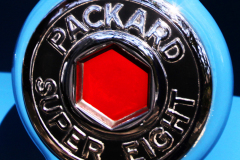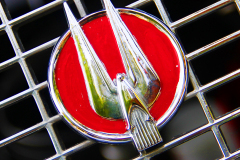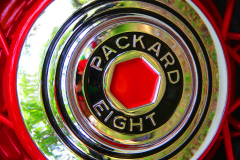Packard | Studebaker
Packard was founded by James Ward Packard, his brother William and their partner, George Lewis Weiss, in the city of Warren, Ohio, where 400 Packard automobiles were built from 1899 to 1903. The Packard Motor Car Company, was formed in 1903 and moved its operations to Detroit, Michigan.
Packards were luxury automobiles and developed a following among wealthy purchasers, both in the United States and abroad. Packards featured many innovations, including the modern steering wheel and air-conditioning.
In the 1920s, Packard exported more cars than any other in its price class. Between 1924 and 1930, it was the top-selling luxury brand – Packard’s slogan was “Ask the Man Who Owns One”.
The Packard Twin Six was introduced in 1932, and renamed the Packard Twelve in 1933. Later models include the Caribbean, Patrician and Clipper.
The company was commonly referred to as being one of the “Three P’s” of American motordom royalty, along with Pierce-Arrow and Peerless. Victims of the Great Depression, Peerless ceased production in 1932 and Pierce-Arrow in 1938.
Famous Packard Mascots/Hood Ornaments were the Cormorant (1926-1950) and the Goddess of Speed (1932-1951). Derisively described as the “pelican” and the “donut chaser”.
Packard had a better cash position than other independent luxury marques and also lower costs due to a single production line and interchangeability between models. Also to address the depression, Packard introduced the medium-price range Packard 120 in 1935. This supplemented the high-priced “Senior” lines (Twelve, Super Eight, and Eight).
The decision to introduce the low priced 1938 Packard Six would hurt Packard in the long run as this model tagged Packards as something less exclusive than they had been in the public’s mind and hurt their reputation of building some of America’s finest luxury cars.
In 1954 Packard bought the failing Studebaker Corporation to form the US’s fourth largest automobile company, declining an alliance with the recently formed American Motor Company (AMC). Although Packard was still in fair financial shape, Studebaker was not. Due diligence was placed behind “merger fever”, and the deal was rushed. It became clear after the merger that Studebaker’s deteriorating financial situation put Packard’s survival at risk.
The last Detroit-built Packard was the 1956 Packard Predictor, their last concept car.
The 1957/1958 Packard Clipper line was produced at South Bend. The cars were a disappointment to devotees and were perceived as having a reduction in quality and a further loss of exclusivity. The new models were christening as “Packardbakers”. The last Packard rolled off the South Bend assembly line on July 1958.
Studebaker’s financial problems were worse than the Packard executives had thought, and in 1962, the Packard marque was phased out, and the company renamed the Studebaker Corporation.
The Studebaker Automobile Company had its origins in1852, in South Bend, Indiana, as a producer of wheelbarrows and wagons for farmers, miners, and the military. In 1857, they built their first carriage – “Fancy, hand-worked iron trim, the kind of courting buggy any boy and girl would be proud to be seen in”.
Studebaker, in various partnerships, entered the automotive business in 1902 with electric vehicles and in 1904 with gasoline vehicles. The first gasoline automobiles to be fully manufactured by Studebaker were produced in 1912.
Studebaker’s aim was “to design for life” producing a series of really rugged cars, the famous “Big Six and Special Six”.
Studebaker had a reputation for good quality, reliability and impressive car designs.
Studebaker prepared well in advance for the anticipated postwar market and launched the slogan “First by far with a post-war car”. A notable model was the 1947 Studebaker Starlight coupé,
Studebaker of Canada Ltd. manufactured cars in Windsor, Ontario, from 1912 to 1936.
Studebaker’s first modern automobile factory was established at Hamilton, Ontario in 1947. Automobiles were manufactured in Ontario with engines produced in the United States.
When it introduced the famous “bullet nose”, in 1950, many thought it too radical for the times. (Although in 1948 Tucker had used one as a third headlight). The bullet nose was featured on three different size models the Champion, Commander and Land Cruiser. The front end of these vehicles was matched with large wrap-around rear windows making for spectacular, streamlined cars. People joked, “Which way is it going?” Studebaker reached its peak years for sales and employment with the 1950 and 1951 bullet nose models.
After years of financial problems, the company merged in 1954 with luxury carmaker Packard to form the Studebaker-Packard Corporation. Studebaker of Canada and Packard Motor Company of Canada also merged in 1954.
Other memorable models were the Hawk series (1950-1964), Lark compact (1959-1966), Avanti sports car (19621964) and the Wagonaire (1963-1966).
Studebaker’s financial problems were worse than the Packard executives had thought. In 1962, the Packard marque was phased out, and the company renamed the Studebaker Corporation.
The South Bend plant ceased production in December 1963 and Studebaker shifted all of its production to Hamilton. The decision was made to focus on the Daytona, Cruiser, Commander and Wagonaire, which were all Lark-type platform variants.
Eventually the Hamilton plant closed and the last Studebaker Cruiser four-door sedan rolled off the Hamilton assembly line in March 1966.



